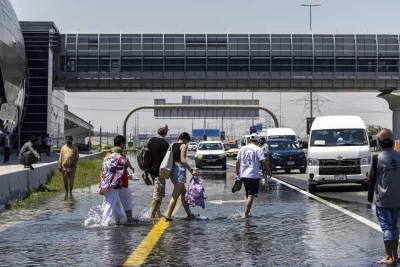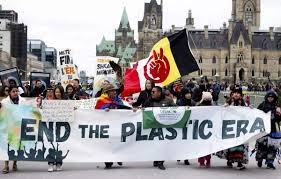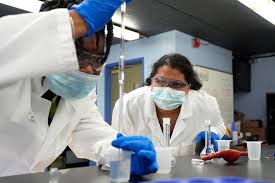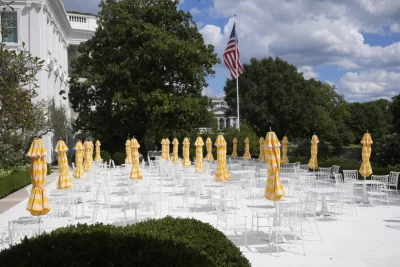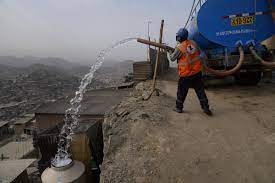
As the world warms from human-caused climate change, fresh water for drinking, cooking and cleaning is becoming harder to get for many people.
That’s because the warming world is leading to erratic rainfall patterns, extreme heat and periods of drought — on top of decades of bad water management and extractive policies around the world. The United Nations estimates that around 2.2 billion people worldwide don’t have access to safely managed drinking water.
This World Water Day, Associated Press journalists from around the world interviewed some of the people struggling to get fresh water.
LIMA, PERU
Justina Flores, a 50-year-old grandmother, lives in a hilly Lima, Peru, suburb with no running water. With some of the water she gets from the government, she washes the clothes of her family of six by hand, and then reuses it to wash the dog or dumps it on the ground outside to keep the dust from coming up and into her house.
Peru’s government gives potable water to 1.5 million of its poorest residents, like Flores, living in the hills. Giant tankers filled with water lug up the steep roads, and the scarce resource often sparks conflicts between neighbors.
Flores tries hard to use as little water as possible for all her daily activities. She has an old washing machine, but washing by hand means she can save about 45 liters (12 gallons) of water per wash.
Peru’s capital, Lima, the second-largest city in the world built on a desert after Cairo, is also one of the most water-stressed. 3.5 million people nationwide are without drinking water connections, about 2 million of them in Lima, according to figures from Superintendencia Nacional de Servicios de Saneamiento (SUNASS), Peru’s public sanitation regulatory body. (Mar. 21)
She and her family get about 3,000 liters (790 gallons) for all their washing, cooking and cleaning each week, while in San Isidro, the richest area of the capital, a family of equal size uses an average of 11,700 liters (3,090 gallons) per week coming from piped water, according to official data.
“In those houses you can bathe as many times as you want. Here, at most, it’s twice a week,” she said, as she looked outside her window at buildings covering the hills.
JAKARTA, INDONESIA
In the vast archipelago nation of Indonesia, access to clean water is uncertain — even in the country’s most-developed city of Jakarta, where over 10 million people live.
Since she was a young girl, Devi Putri Eka Sari, now a 37-year-old mother of three, has had to buy water from the vendors going up and down the narrow paved streets in her lower-income neighborhood — even after the government installed water pipes and pumps pulling water from the ground.
Government water isn’t reliable, she says: Sometimes it just drips from the tap when she turns it on. Even if it did flow regularly, she wouldn’t dare use it for drinking.
“It’s not healthy. It’s filled with bacteria that will make you sick,” she said. “It smells like a pool, like chemicals.”
Her fear about bacteria isn’t unfounded: Seven out of 10 Indonesian households consume drinking water contaminated with E. coli, according to the World Health Organization.
Instead Sari, like millions of Indonesians across the country, buy water in large refillable containers or single-use packaged plastic bottles. They’re easy to find, but create large amounts of trash in the cities’ already plastic-choked waterways.
“It’s what I’ve been doing my whole life,” said Sari. “It’s the option we have.”
RAS EL MA, MOROCCO
Mimoun Nadori crouches to dip his hand into the river and taste the water next to groves where his family has long grown fruits and vegetables on their northern Morocco farms.
He grimaces. It’s salty. But it didn’t used to be this way.
“Everything was green,” he remembers. “We drank from the river and washed with the river. We made a life with it.”
But less rainfall and more damming and pumping upstream has left less water flowing through Morocco’s Moulouya River and threatened the livelihoods of farmers like Nadori. Where the river once flowed from the mountains into the Mediterranean, it now sits stagnant, allowing seawater to creep inland and turning water from a source of life to a deadly poison.
Less rainfall and more damming and pumping upstream has left less water flowing through Morocco’s Moulouya River, threatening the livelihoods of farmers like Mimoun Nadori. (AP Video: Oussama Alaoui)
Nadori started importing water for the on-site chicken coop he manages after his cows accustomed to drinking from the river died. He knew neither that the water was brackish nor that they were feeding from it until they wound up dead.
Overuse of the river has also put new pressures on the reserves of water that lie beneath the ground as Moroccan farmers like Nadori — as well as those on the other side of the nearby Algerian border — dig more wells to compensate for the loss of their former supply.
“We won’t lie and say the reason is only humans or drought, it’s both,” he said. “We don’t know how to use water and we waste a lot of water.”
CORNING, CALIFORNIA
There was a time when the water in Fred and Robin Imfeld’s pool shimmered on hot summer days and their yards were lush with plants.
But two years ago, the well that supplied water to their home in rural Corning, California, went dry for the first time in some 40 years. Now the pool is empty, and their trees are shades of rust.

